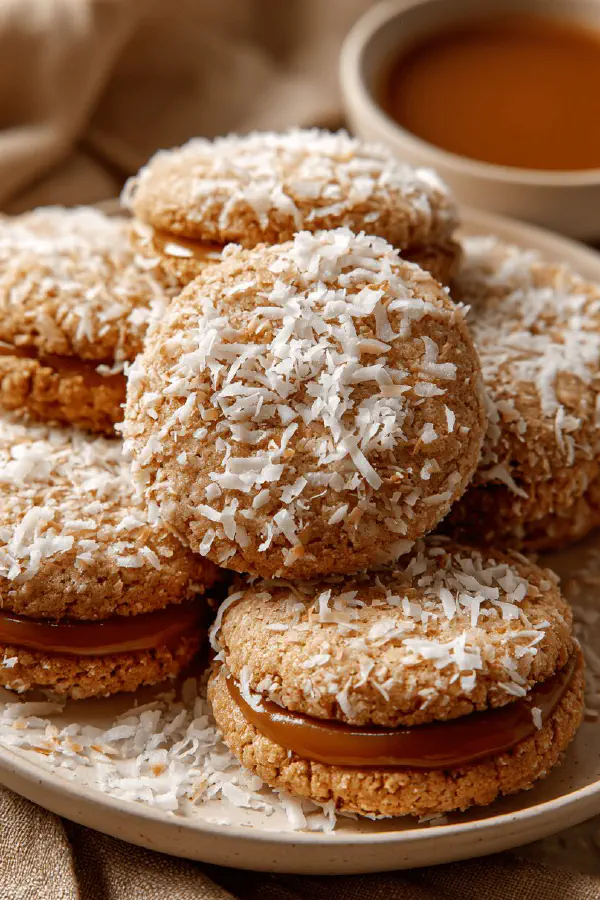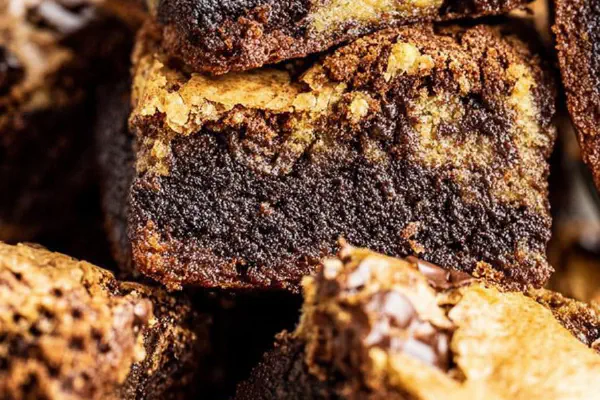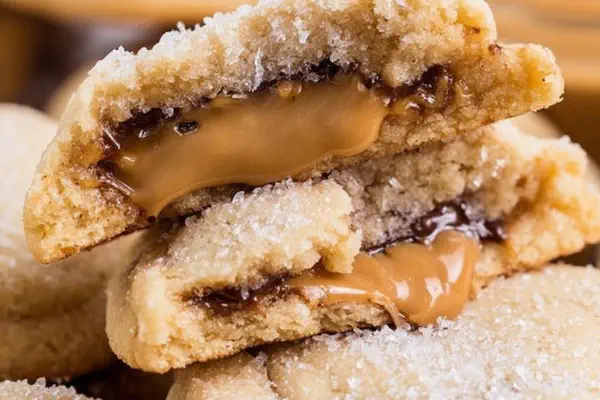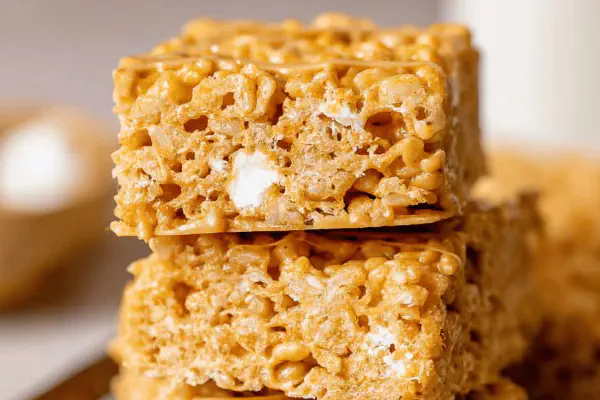Featured Recipe
Soft Dulce de Leche Sandwiches

By Kate
"
Tender round cookies filled with dulce de leche and coated with toasted shredded coconut. Butter and sugar creamed for a denser crumb. Baking powder swapped for baking soda plus a pinch of salt for balanced rise. Flour mostly whole wheat for nuttiness and chew. Replace vanilla with almond extract—adds complexity. Toast coconut to deepen flavor. Pliable dough chills then rolls thin for even baking. Sandwich assembly rolls edges for chew, prevents mess. Store wrapped at room temp, lasts 3 days max. Texture soft, slight chew from coconut. Aroma sweet caramel, hint almond. Requires seeing golden edges to know done.
"
Prep:
40 min
Cook:
15 min
Total:
55 min
Serves:
6 servings
dessert
cookies
Latin-inspired
snacks
Introduction
Soft cookies, round and tender. Sweet caramel scent fills kitchen mixing into warm butter sugar clouds. No cutting corners on chill time—dough must rest or it shrinks in oven. Use a mix of wheat flours for character and structure—adds chew, bites back when you least expect it. Almond extract cuts the sweetness with nutty spice; vanilla lacks that punch. Toasted coconut for a crunchy sweet dusting, not just decoration—it bursts with color and flavor when browned just right. Bakes best on parchment to catch melting sugar droplets and keep bottoms light. The moment edges turn gold—eyes on the prize—pull from oven before drying out. Build sandwiches quickly; dulce de leche sticky and slow to dry. Roll sides for neatness, a little sticky mess is inevitable but manageable. Store at room temps only, but not past day three unless you want dense rocks. Basically, know your dough, your bake, your textures. Then you can break rules.
Ingredients
About the ingredients
Switched original flour quantities—mostly whole wheat for chew and hearty flavor; all-purpose remains to keep dough tender and workable. Baking soda replaces baking powder to react with brown sugar acids for leavening while balancing with salt. Salt added deliberately to awaken flavors and balance sweetness. Brown sugar provides moisture and a subtle molasses depth that white sugar misses. Almond extract swaps classic vanilla, bringing out nutty warmth and adding unexpected complexity to dulce de leche’s sweetness—feel free to revert if preferred. Toasted coconut done dry in pan; easiest and more aromatic than oven. Dulce de leche quality matters—homemade runs too soft, store bought is denser and cleaner for spreading. Butter must be softened, not melted, or creaming loses air and cookies flatten. Egg yolk alone enriches without extra liquid from whites, keeps cookie tender and rich. Measure carefully; mismeasuring wheat flours alters texture drastically.
Method
Dough Prep
- Sift whole wheat flour, all-purpose flour, baking soda and salt into one bowl. Mix to combine evenly. Toast shredded coconut on dry pan over medium heat constantly stirring till golden, fragrant, then set aside cool.
- In larger bowl, beat softened butter and brown sugar using electric mixer till fluffy and light cream color—about 3-4 minutes. Incorporate egg yolk and almond extract; beat until no streaks, smooth and shiny.
- Add dry ingredients gradually using wooden spoon, fold just until no visible flour remains. Less handling avoids tough cookies. Gather dough, pat into disk, wrap tightly with plastic wrap. Refrigerate minimum 40 minutes to relax gluten and firm up butter.
- Position oven rack mid-level. Preheat oven to 175°C (350°F). Line baking sheet with parchment paper or silicone mat.
- Dust work surface lightly with flour. Roll dough out evenly with rolling pin to about 3.5 mm thickness (just under 1/8 inch). Avoid sticking or tearing by lifting and turning dough frequently with spatula.
- Use a 5.5 cm round cutter to stamp 18 disks straight down without twisting. Place cookies spaced on lined tray.
- Bake 13-15 minutes. Watch for edges turning golden and surface firm but still soft in center. Bottom should brown slightly—not burnt. Remove from oven, slide parchment on rack to cool fully before touch or assembly. Warm cookies crumble or deform.
- Match cookies into pairs of similar size. Spread 15 ml dulce de leche on one disk. Sandwich with second. Spread remaining dulce de leche on top and sides like a thin glaze.
- Roll edges of each sandwich gently in toasted coconut pressing lightly to adhere. Handles sticky edges carefully.
- Store in airtight container at room temperature up to 3 days. Coconut softens over time but remains aromatic. Do not refrigerate or cookies become firm and lose tenderness.
- Whole wheat adds chew but can dry dough; don’t over bake. Always use room temp butter for creaminess. Brown sugar adds moisture and caramel notes; white sugar creates drier texture.
- Almond extract swaps vanilla for aromatic twist but omit if allergic, use vanilla as default.
- If dough sticky after chilling, dust gently with flour; too much flour toughens dough.
- Dulce de leche must be thick. Runny or homemade with high moisture causes soggy cookies. Reduce spread amount if necessary.
- To toast coconut evenly, stir constantly to avoid burning some flakes while others stay raw.
- Rolling dough too thin means cookie will burn quickly. Too thick means raw center. Aim for 3-4 mm thickness.
- Baking times vary by oven. Visual cues matter more. Slight golden color on edges, firm top while center springy to touch indicates doneness.
- If sandwich softens excessively next day, enjoy quickly next time or refrigerate before serving to firm up slightly.
Shaping and Baking
Assembly
Tips and Troubleshooting
Technique Tips
Many overlook proper creaming—beat butter and sugar well to trap air, essential to light crumb. Sloppy cream leads to dense cookies. Use wooden spoon for folding dry ingredients; electric mixer overworks gluten causing stiffness. Dough will feel soft but firm after chilling; too cold means cracking when rolled, too warm means stickiness. Roll on floured counter but sparingly to not dry edges. Cut cookies cleanly; no twisting or edges crumble. Baking is all about cues: slight golden edge, surface no longer shiny, but center still soft to touch. Removing too soon creates doughy bites; too late equals dry cracker. Cooling fully on wire rack avoids sogginess and breaking during handling. Spread filling gently but fully; thicker layers mean more mess. Rolling side edges in coconut seals edges, prevents filling oozing out. Use fingertips to press coconut gently, not rub. Store sandwiches airtight at room temp—refrigerating turns butter hard and dough tough. Eat fast for best texture. You will hear cracking as cookies break soft under pressure but still moist inside.
Chef's Notes
- 💡 Use toasted coconut. Enhances flavor. Always keep stirring on heat. Watch for even browning, or it burns. Simple trick, lots of impact.
- 💡 Chill dough well. Resting lets gluten relax. Skip this and cookies shrink when baking. Wrap tightly, minimum 40 minutes. Pat into a disk.
- 💡 Monitor baking time. Visual cues matter more than clocks. Look for golden edges, firm surface. Soft center means it’s not overbaked.
- 💡 Ensure butter is room temp. Softens properly for creaming. Cold butter leads to dense cookies, while melted ruins airy texture.
- 💡 If dough sticks, dust lightly. Too much flour firms it up. Roll out on floured surface. Don’t twist, or edges will crumble.
Kitchen Wisdom
Can I substitute the dulce de leche?
Sure, caramel sauce works too. But thickness is key. Use a thick version or it'll ooze.
How to store these cookies?
Airtight container at room temp. Avoid fridge, texture changes. Up to 3 days. Fast consumption recommended.
What if cookies are too dry?
Could mean overbaked or too much flour. Next time, check baking time carefully. Adjust flour too.
Can I use regular flour instead?
Yes. All-purpose only, though. Consider adding a bit of nutty flavor – use some whole wheat.



